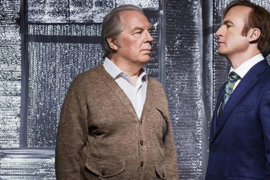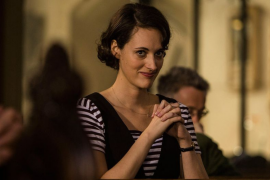IT IS NOW OVER FIFTY YEARS SINCE THAT ICONIC SCIENCE FICTION MOVIE, 2001: A Space Odyssey—based on the short story, “The Sentinel” by Arthur C. Clarke, who went on to co-write the movie, with the director, Stanley Kubrick—was released to the viewing public. Anyone who has seen it on the wide screen will attest to its incredible poetic power, and the awesome quality of its imagery. Indeed you could almost compare it to a drug trip, without the drawbacks and negative side effects. And this is a movie, to be fully appreciated, that needs to be seen on the cinema screen rather than the TV. And of course the fact that its release coincided with the Apollo Moon landings—when the public was already hyped up about manned space flights—only added to its potency and appeal. And yet as haunting and powerful as the movie is, it is hard, one might almost say impossible, to discern what it was all about, or what message, if any, it bore.
The movie is divided into four parts—Kubrick himself compared them to the movements in a symphony. It opens at the dawn of history with a struggle between two groups of human looking apes—when a mysterious monolith appears in the heavens, which seems to impart some spark of intelligence to some of those creatures, as if impelling them on the first steps of human evolution. Then, thousands of years later, there is a mission to the Moon, under a cloak of secrecy, to investigate that same monolith, which had landed on a remote spot on the lunar planet. Though when the astronauts approach the monolith it emits a harsh ear-splitting noise that incapacitates them and prevents them from contacting and examining it. Then, some years afterwards, there is a manned mission, purportedly to Jupiter, but whose real purpose, which is even unbeknown to the astronauts, is to contact the monolith, which is believed to be in the vicinity of Jupiter. This is where we are memorably introduced to the talking computer in control of the ship, Hal. Indeed Hal, with his splendidly creepy voice, has a more vivid personality than the two rather robotic human astronauts aboard the same vessel, or indeed anyone else in the movie. You could say that he is the only real, rounded character in the film.
As with many of Kubrick’s films, you get the impression that he was more interested in things, processes and mechanisms, than in people. One thinks of the vast, creepy, out of season hotel in the Shining, or the elaborate racetrack heist in the Killing, or the inexorable steps that lead to universal Armageddon in Doctor Strangelove. Indeed the spaceship, on its enigmatic mission to Jupiter—like the labyrinthine hotel in the Shining—is like a character in its own right.
As any kind of prediction of the future—though to be fair it didn’t set out to do such – it was way off target. It envisages a huge settlement on the Moon, the size of a town or a small city, when Moon exploration itself was soon deemed to be far too expensive, with far too few returns for the vast resources invested, and was wrapped up with the last of the Apollo missions. Though because of the fantastic sets, and special effects, and Kubrick’s almost manic attention to detail, you have an almost palpable sense, while watching the movie, of what it would feel like to be part of a manned space mission. Compared with this most other science fiction movies and TV series seem contrived and antiseptic. So that when you are watching, say, an episode of Star Trek, you realise that you are looking at the interior of a TV studio. With Kubrick you are willing to suspend disbelief. Indeed has a science fiction movie ever had better, and more convincing special effects, than this one?
Some of the imagery is truly mesmerising; as in those early scenes when a spaceship approaches and then lands inside a huge, revolving space station, to the accompaniment of The Blue Danube; and in the haunting shots of the Moon’s surface, lit by the reflected light of the Earth, as a manned space module flies overhead, from the Moon base, in order to investigate the mysterious monolith that had recently landed. And when you add the incredible music score—with its potent mix of old classics, from Strauss to Khachaturian, along with the spellbinding music of the contemporary composer, Ligetti—it puts it into another dimension. Like Bernard Herman’s haunting music for Psycho, 2001 is a striking example of how an imaginative score can add to the power and effectiveness of a movie. Indeed the imagery and the music, rather than the dialogue, of which there’s not a great deal, are the driving forces in the film.
The Jupiter Mission is, in my view, the most dramatic and gripping part of the movie. Indeed the struggle between the astronauts, and the controlling computer, Hal, could have been a movie in its own right, dispensing with all the other elements, including the mysterious monolith. It could have been a cautionary tale, or devastating satire, on man’s prickly, uncertain relationship with his own technological creations. (Just as his earlier movie, Doctor Strangelove, was a brilliant, mordant satire on the scarifying lunacies of the Nuclear Arms Race, during the Cold War era). Instead however it floats away in the end on a cloud of pretentious, gimcrack, New Age pseudo-mysticism. This is why, for all its power, it lacks the thematic unity and coherence of a movie like Alien; or indeed of Doctor Strangelove.
The last surviving astronaut, played by Kier Dullea, realising that the computer had killed his partner and turned off the life-support systems for those astronauts that had been placed in a state of suspended animation, sets out to dismantle and destroy Hal. And we hear its personality disintegrate away to nothingness as it sings, ‘Daisy, Daisy, Give Me Your Answer Do.’ Now entirely alone, the astronaut ends up on a wild, almost psychedelic space trip, beyond his control or understanding. He finishes up confined in some weird Louis the Sixteenth interior, with an illuminated glass floor. There he rapidly ages and becomes bedridden, and then sees the mysterious monolith, which appeared at the beginning of the movie, planted on the floor before his bed. Then he turns into a giant embryo, in a protective membrane – which may or may not represent the next stage of human evolution – before floating off into the far reaches of space. As for the monolith; we hardly know anything about it, other than that it has a strange, disturbing effect on any humans it happens to come in contact with. We aren’t told where it is from, or why it came to the earth and contacted humans. It’s like a shade cast by a shadow. It’s small wonder that, as Arthur C. Clarke later said, the movie seemed to appeal more to hippies and dropouts than it did to your average sci-fi fans. Indeed the more orthodox within the science fiction community were never taken with the movie at all. Perhaps this is a case of a movie where you should forget about the message, if there is one anyway, and just enjoy the ride. It is indeed one of the great cinematic roller coaster rides, though it ends with no discernible or coherent conclusion whatsoever. It’s doubtful if even Kubrick himself knew what it was all about. And movie critics and film buffs are still debating what it was trying to say, to this day, with no definitive and agreed explanation being forwarded. It is very much a case of draw your own conclusions. Though the very fact that it is still being watched – indeed some years ago it was shown in cinemas across the world – and being talked about, is a testament to its power. And it will continue to fascinate and intrigue in the years to come.
Like a lot of futuristic literature, and science fiction, it tells us far more about ourselves—and the concerns, mores and fixations of the times in which it was created—than it does about the future. It is a testament, not to man’s future in space, but to the Sixties infatuation with psychedelia, the hippy movement, flower power, the gnomic utterances of the Maharishi, and some of the sloppy, pseudo-mysticism that was fashionable at the time, but which now seems cringe making and embarrassing. Far from being a signpost to the future, it even carries some quaint baggage from the present with it, with, as Lewis Mumford wryly pointed out, a Johnson’s diner on board the space station. Like the Beetles records, it is an icon of the Sixties, and it contains within it some of the hopes, dreams and illusions of that inimitable and confused decade.
Like what you’re reading?
Get new stories or poetry sent to your inbox. Drop your email below to start >>>
OR grab a print issue
Stories, poems and essays in a beautifully designed magazine you can hold in your hands.
GO TO ISSUESNEW book release
I’ll Tell You a Love Story by Couri Johnson. Order the book of which Tim Jeffries said, “Surprising in their originality, filled with broken wisdom, and with a refreshing use of language and imagery, these are stories to savour and mull over one at a time but which add up to a satisfying whole.”
GET THE BOOK



